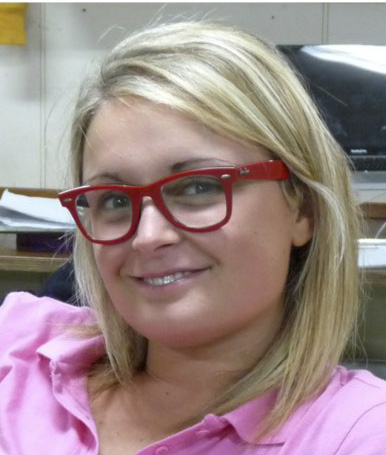 Technician
Technician
Stazione Zoologica Anton Dohrn
Sicily Marine Center, Messina, Italy
Contrada Porticatello, 29 – Villa Pace, 98167
Tel.081.5833785
E-mail: This email address is being protected from spambots. You need JavaScript enabled to view it.
Skype: Erika.arcadi
Short CV
- (2010) - Laurea Triennale in Biologia ed ecologia marina presso l’Università degli Studi di Messina con 110/110 e lode con tesi dal titolo: “Caratterizzazione filogenetica delle comunità microbiche presenti nel nuovo bacino anossico iperalino profondo Thetis (Mar Mediterraneo Orientale”.
- (2011) - Laurea Magistrale in biologia ed Ecologia dell’ambiente marino e costiero presso l’Università degli Studi di Messina con 110/110 e lode con tesi dal titolo: “Studio mediante fish e card-fish delle comunità microbiche nel redoxcline pelagico di aree mediterranee”.
- (2009-2012) - Tirocinio formativo e curriculare presso Lab. Ecologia Microbica e Biotecnologie di IAMC-CNR Messina.
- (2012-2015) - Dottorato di Ricerca in “Scienze ambientali: ambiente marino e risorse” XXVII ciclo con tesi dal titolo: “Lo studio della vita procariotica e dei relativi processi metabolici ai limiti della termodinamica in ambiente anossico iperalino”.
- (2015-2016) - Borsa di Ricerca EcoMar presso IAMC CNR Messina.
- (2019-2020) Borsa di Ricerca AbbaCo presso SZN, Sicily Marine Centre, Messina.
- (2021-giugno 2023) - Assegno di Ricerca Senior su progetto PON-Marine Hazard presso SZN, Sicily Marine Centre, Messina.
- (luglio 2023- ad oggi) - CTER IV Livello professionale e Responsabile Area Funzionale Laboratorio Ecologia Microbica marina e Biotecnologie Marine presso SZN Sicily Marine Centre, Messina.
_____________________________________________________________________________
- (2010) - Bachelor's Degree in “Biology and Marine Ecology” at the University of Messina with 110/110 cum laude with a thesis entitled: “Phylogenetic characterization of the microbic communities present in the new deep hyperhaline anoxic basin Thetis (Eastern Mediterranean Sea)”.
- (2011) - Master's degree in “Biology and Ecology of the Marine and Coastal Environment” at the University of Messina with 110/110 cum laude with thesis entitled: "Study using fish and card-fish of microbial communities in the pelagic redoxcline of Mediterranean areas”.
- (2009-2012) - Training and curricular internship at the Microbial Ecology and Biotechnology Lab of IAMC-CNR Messina.
- (2012-2015) - PhD in "Environmental sciences: marine environment and resources" XXVII cycle with thesis entitled: "The study of prokaryotic life and related metabolic processes at the limits of thermodynamics in anoxic hyperhaline environment".
- (2015-2016) - EcoMar Research Grant at IAMC CNR Messina.
- (2019-2020) - AbbaCo Research Fellowship at SZN, Sicily Marine Centre, Messina
- (2021-June 2023) Senior Research Fellow on PON-Marine Hazard project at SZN, Sicily Marine Centre, Messina.
- (July 2023 - to date) - CTER IV Professional level and Functional Area Manager Marine Microbial Ecology and Marine Biotechnology Laboratory at SZN Sicily Marine Centre, Messina.
Tasks
• Exploration and study of the microbial diversity of extreme marine environments.
• Study of the microbiome (gastrointestinal tract, skin, gills) of fish species;
• DNA/RNA extraction from water, sediments, cell cultures, animal tissues
• Isolation and physiological characterization of marine microorganisms in aerophilia, microaerophilia and anoxia;
• Cultivation, characterization, isolation and physiology of marine microorganisms (Bacteria and Archaea) in microaerophilic and anoxic conditions, in different culture media;
• Selections of microorganisms through the use of antibiotics;
• Taxonomic identification of bacteria through 16S rDNA analysis;
• Analysis of mixed microbial communities, construction of clone libraries;
• Rapid diagnosis of bacterial infections through the use of molecular markers; Monitoring of contaminated marine areas through the use of molecular markers;
• Use of bacterial species and/or enzymes for monitoring pollution in the marine environment;
• Monitoring the expression of functional genes in natural samples via Real Time PCR;
• Quantitation of bacterial cells in natural samples and fish tissues using DAPI, FISH and CARD-FISH;
• Use of image acquisition systems; mtDNA and use of genetic markers (Cytochrome oxidase 1 and Control Region).
Selected Publications
- Arcadi E, Rizzo C, Calogero R, Sciutteri V, Fabiano F, Consoli P, Andaloro F and Romeo T (2023) Microbial communities inhabiting shallow hydrothermal vents as sentinels of acidification processes. Frontiers in Microbiology.
(DOI: 10.3389/fmicb.2023.1233893)
- Arcadi E, Rastelli E, Tangherlini M, Rizzo C, Mancuso M, Sanfilippo M, Esposito V, Andaloro F and Romeo T (2022) Shallow-water hydrothermal vents as natural accelerators of bacterial antibiotic resistance in marine coastal areas. Microorganisms MDPI.
(DOI: 10.3390/microorganisms10020479)
- La Cono V, Messina E, Rohde M, Arcadi E, Ciordia S, Crisafi F, Denaro R, Ferrer M, Giuliano L, Golyshin PN, Golyshina OV, Hallsworth JE, La Spada G, Mena MC, Shevchenko MA, Smedile F, Sorokin DY, Toshchakov SV, Mushegian A, Yakimov MM (2020) Symbiosis between nanohaloarchaeon and haloarchaeon is based on utilization of different polysaccharides. PNAS August 18, 2020 117 (33) 20223-20234.
(DOI: 10.1073/pnas.2007232117)
- Golyshina OG, Toshchakov SV, Marakova KS, Gavrilon SN, Korzhankov AA, La Cono V, Arcadi E, Nechitaylo TY, Ferrer M, Kublanov IV, Wolf YI, Yakimov MM, Golyshin PN (2017). 'ARMAN' archaea depend on association with euryarchaeal host in culture and in situ. Nature Communication.
(DOI: 10.1038/s41467-017-00104-7)
- La Cono, V., Arcadi E, La Spada G, Barreca D, Laganà G, Bellocco E, Catalfamo M, Smedile F, Messina E, Giuliano L, and Yakimov MM (2015). A three‐component microbial consortium from Deep-sea salt-satured anoxic Lake Thetis links anaerobic glycine betaine degradation with methanogenesis. Microorganisms










